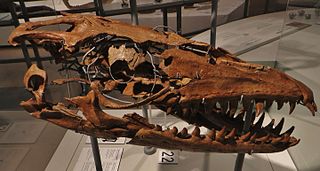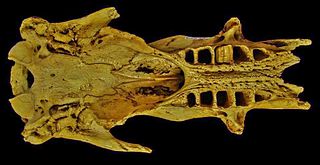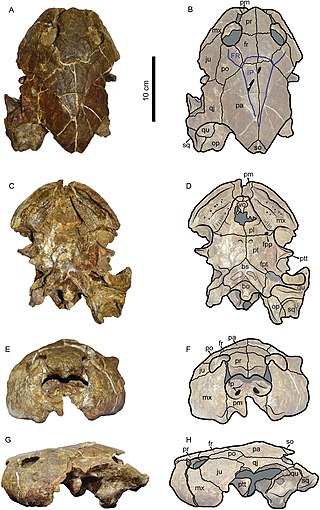
Dorudon ("spear-tooth") is a genus of extinct basilosaurid ancient whales that lived alongside Basilosaurus 40.4 to 33.9 million years ago in the Eocene. It was a small whale, with D. atrox measuring 5 metres (16 ft) long and weighing 1–2.2 metric tons. Dorudon lived in warm seas around the world and fed on small fish and mollusks. Fossils have been found along the former shorelines of the Tethys Sea in present-day Egypt and Pakistan, as well as in the United States, New Zealand and Western Sahara.

Thalassodromeus is a genus of pterosaur that lived in what is now Brazil during the Early Cretaceous period, about a hundred million years ago. The original skull, discovered in 1983 in the Araripe Basin of northeastern Brazil, was collected in several pieces. In 2002, the skull was made the holotype specimen of Thalassodromeus sethi by palaeontologists Alexander Kellner and Diogenes de Almeida Campos. The generic name means "sea runner", and the specific name refers to the Egyptian god Seth due to its crest being supposedly reminiscent of Seth's crown. Other scholars have pointed out that the crest was instead similar to the crown of Amon. A jaw tip was assigned to T. sethi in 2005, became the basis of the new genus Banguela in 2014, and assigned back to Thalassodromeus as the species T. oberlii in 2018. Another species was described in 2015 based on a supposed crest fragment, but this was later shown to be part of a turtle shell.

Meiolania is an extinct genus of meiolaniid stem-turtle native to Australasia throughout much of the Cenozoic. Meiolania was a large turtle, with the shell alone ranging from 0.7–2 m in length. Four species are currently recognized, although the validity of two of them is disputed. Meiolania was first described as a species of lizard related to Megalania by Richard Owen towards the end of the 19th century, before the continued discovery of additional fossils solidified its placement as a kind of turtle.
Platecarpus is an extinct genus of aquatic lizards belonging to the mosasaur family, living around 84–81 million years ago during the middle Santonian to early Campanian, of the Late Cretaceous period. Fossils have been found in the United States and possible specimens in Belgium and Africa. A well-preserved specimen of Platecarpus shows that it fed on moderate-sized fish, and it has been hypothesized to have fed on squid, and ammonites as well. Like other mosasaurs, it was initially thought to have swum in an eel-like fashion, although another study suggests that it swam more like modern sharks. An exceptionally well-preserved specimen of P. tympaniticus known as LACM 128319 shows skin impressions, pigments around the nostrils, bronchial tubes, and the presence of a high-profile tail fluke, showing that it and other mosasaurs did not necessarily have an eel-like swimming method, but were more powerful, fast swimmers. It is held in the Natural History Museum of Los Angeles County. Isotopic analysis on teeth specimens has suggested that this genus and Clidastes may have entered freshwater occasionally, just like modern sea snakes.

Globidens is an extinct genus of mosasaurid oceanic lizard classified as part of the Globidensini tribe in the Mosasaurinae subfamily.

Prognathodon is an extinct genus of marine lizard belonging to the mosasaur family. It is classified as part of the Mosasaurinae subfamily, alongside genera like Mosasaurus and Clidastes. Prognathodon has been recovered from deposits ranging in age from the Campanian to the Maastrichtian in the Middle East, Europe, New Zealand, and North America.
Gamerabaena is an extinct genus of baenid turtle which existed in North Dakota during the late Cretaceous Period. It is known from a single fragmentary skull that was found in the Maastrichtian-age Hell Creek Formation. It contains the species Gamerabaena sonsalla. Gamerabaena is similar to the genus Palatobaena, but it differs in its lack of a posterior expansion of the triturating surface, a somewhat rectangular skull, and a wide angle between the maxillae. Gamerabaena also has a lingual ridge on the inner side of the jaw that is not seen in Palatobaena.
Eremiasaurus is a genus of mosasaurs, an extinct group of marine reptiles. It lived during the Maastrichtian stage of the Late Cretaceous in what is now North Africa. Only one species is known, E. heterodontus, described in 2012 from two remarkably complete fossil specimens discovered in the Ouled Abdoun Basin, Morocco. This site is known to have delivered a significant number of other related mosasaurs.

Foxemys is an extinct genus of bothremydid turtle that was discovered at Fox Amphoux, France and also Hungary and Spain. Its skull and shell structure is similar to Polysternon. Two species are in the genus: F. mechinorum and F. trabanti.
Glyphoderma is an extinct genus of placodont reptile from the Middle Triassic of China with two known species, G. kangi and G. robusta. It differs from its relative Psephochelys in having three, rather than one, fused osteoderms on the posterior skull surface, and has an earlier temporal range, from the Ladinian epoch rather than the Late Triassic. Otherwise, it is similar in most respects to the other plachochelyids found in China. The name comes from the Greek 'γλυφος', 'sculpture' and 'δερμα', 'skin' referring to its unique carapace structure. The specific name honours a Mr. Kang Ximin.

Thalattoarchon is an extinct genus of large predatory ichthyosaurs that lived during the Anisian stage of the Middle Triassic in what is now North America. The only known species is T. saurophagis, described in 2013 from a single specimen discovered in the Favret Formation, Nevada. The generic name, meaning "ruler of the seas", refers to its status as an apex predator, while the specific epithet, meaning "lizard eater", alludes to its carnivorous diet. The classification of this genus within the ichthyosaurs is much debated, being either classified within the clade Merriamosauria or in the more basal family Cymbospondylidae.

Diabolotherium is an extinct genus of megatheriine ground sloth, known from the Late Pleistocene of Peru. Unlike most other extinct mainland sloths, it seems to have been a climber, similar to extinct sloths from the Caribbean. Fossils of the genus were found at the coastal Piedra Escrita site and the Andean Casa del Diablo cave.
Araiochelys is an extinct genus of bothremydid pleurodiran turtle that was discovered in the Ouled Abdoun Basin, Morocco. The genus consists solely of type species A. hirayamai.
Rosasia is an extinct genus of bothremydid pleurodiran turtle that was discovered in the Argilas de Aveiro Formation of Portugal. The genus consists of a single species, R. soutoi, named after Alberto Souto.
Arenila is an extinct genus of bothremydid pleurodiran turtle that was discovered in the Western Desert of Egypt. The genus consists solely of type species A. krebsi.

Chinatichampsus is an extinct genus of crocodilian from the Devil's Graveyard Formation of Texas, specifically the Dalquest Desert Research Site. It is a monotypic genus, containing only the type species Chintanichampsus wilsonorum. A single specimen, TMM 45911–1, was first discovered in 2010. Chinatichampsus is the most basal Eocene caimanine, dating to between 42.8 and 41.5 million years ago, and is considered to be more basal than Protocaiman.

Caninemys is an extinct genus of large freshwater side-necked turtle, belonging to the family Podocnemididae. Its fossils have been found in Brazil and Colombia, in rocks dating back from the middle to late Miocene.

Stegouros is a genus of ankylosaurian dinosaur from the Late Cretaceous Dorotea Formation of southern Chile. The genus contains a single species, Stegouros elengassen, known from a semi-articulated, near-complete skeleton.

Kosmodraco is a genus of large bodied choristodere from the Paleocene of North America. Originally described as a species of Simoedosaurus, it was found to represent a distinct genus in 2022. Multiple fossil skulls show a relatively short and robust snout and a skull that is considerably wider behind the eyes. Two species are currently recognized, K. dakotensis and K. magnicornis.
Eurycephalosuchus is an extinct genus of orientalosuchine alligatoroid from the Late Cretaceous Jiangxi Province of China. Known from a well preserved skull and mandible alongside various postcranial remains, Eurycephalosuchus possessed a short and broad skull with a very short skulltable. Eurycephalosuchus lived with at least one other crocodilian, an indetermined member of the clade Brevirostres. The genus is monotypic, containing only the species Eurycephalosuchus gannanensis.











